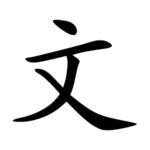Radical 67
| 文 | ||
|---|---|---|
| ||
| 文 (U+6587) "script, literature" | ||
| Pronunciations | ||
| Pinyin: | wén | |
| Bopomofo: | ㄨㄣˊ | |
| Gwoyeu Romatzyh: | wen | |
| Wade–Giles: | wên2 | |
| Cantonese Yale: | màhn, mahn | |
| Jyutping: | man4, man6 | |
| Pe̍h-ōe-jī: | bûn | |
| Japanese Kana: | ブン bun / モン mon (on'yomi) ふみ fumi (kun'yomi) | |
| Sino-Korean: | 문 mun | |
| Names | ||
| Chinese name(s): | (Top) 文字頭/文字头 wénzìtóu 文字旁 wénzìpáng | |
| Japanese name(s): | 文/ぶん bun 文繞/ぶんにょう bunnyō 文旁/ふみづくり fumizukuri | |
| Hangul: | 글월 geurwol | |
| Stroke order animation | ||
 | ||
Radical 67 or radical script (文部) meaning "script" or "literature" is one of the 34 Kangxi radicals (214 radicals in total) composed of 4 strokes.
In the Kangxi Dictionary, there are 26 characters (out of 49,030) to be found under this radical.
文 is also the 93rd indexing component in the Table of Indexing Chinese Character Components predominantly adopted by Simplified Chinese dictionaries published in mainland China.
Evolution
[edit]-
Oracle bone script character
-
Bronze script character
-
Large seal script character
-
Small seal script character
Derived characters
[edit]| Strokes | Characters |
|---|---|
| +0 | 文 |
| +2 | 齐SC (=齊 -> 齊) 刘SC (=劉 -> 刀) |
| +4 | 斉JP (=齊 -> 齊) |
| +6 | 斊 斋SC (=齋 -> 齊) |
| +7 | 斍 (=覺 -> 見) 斎JP (=齋 -> 齊) 斏 |
| +8 | 斌 斐 斑 |
| +9 | 斒 |
| +12 | 斓SC (=斕) |
| +15 | 斔 |
| +17 | 斕 |
| +19 | 斖 |
The Unihan Database classifies the Simplified Chinese character 齐 and Japanese shinjitai 斉 and 斎 under this radical. However, 齐 actually belongs to radical 齐 (齊) (Simplified Chinese characters radical #140, =Kangxi Radical 210) in mainland China's standard[1] and Simplified Chinese dictionaries; 斉 and 斎 usually falls under radical 斉 (齊) (or "齊 (斉)" depending on each dictionary's standard) in Japanese dictionaries.
Sinogram
[edit]The radical is also used as an independent Chinese character. It is one of the Kyōiku kanji or kanji taught in elementary school in Japan.[2] It is a first grade kanji.[2]
References
[edit]Literature
[edit]- Fazzioli, Edoardo (1987). Chinese calligraphy : from pictograph to ideogram : the history of 214 essential Chinese/Japanese characters. calligraphy by Rebecca Hon Ko. New York: Abbeville Press. ISBN 0-89659-774-1.
- Lunde, Ken (Jan 5, 2009). "Appendix J: Japanese Character Sets" (PDF). CJKV Information Processing: Chinese, Japanese, Korean & Vietnamese Computing (Second ed.). Sebastopol, Calif.: O'Reilly Media. ISBN 978-0-596-51447-1.




